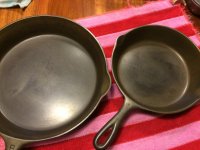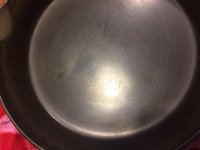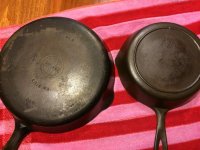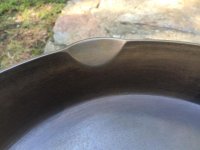My sister found me these two (I think fairly decent) pans at a flee market and they were covered with rust, but most of that easily came off with hot water and a good scrubbing with the fake steel wool dish scrubby thing. The large one on the left is my main concern. It appears to have 2 tiny pits in the middle left side, and I may have scrubbed too hard with the scrubby cause you can see scratch lines on the surface. :-( Other than the pits, the surface is totally smooth, with only a tiny bit more drag on the areas where I may have scrubbed too hard. Also the bottom of the large pan (pictured on teh left), definitely has more build up. But do I need to get this off? I'd like to get these pans cleaned up and seasoned correctly, but I just want serviceable skillets and don't want to go to a large amount of effort if it doesn't necessarily have to come off of the bottom. And lastly, there appears to be a slightly yellow-orangey haze around the inner sides of the skillets, especially the upper sides of the large skillet (again pictured left). I felt like I scrubbed the rust off really well, but is this rust nestled down in somehow and would the vinegar bath be suitable to try for this? Thanks for your help!! I'm very new to cast-iron and in spite of reading, I still wish I had a set of knowledgeable eyes looking over my shoulder telling me what the right thing to do is!
-
If a web search for the answer to your cast iron cookware question has brought you directly to this forum, the information you seek may be covered in one of the many reference topics featured on the main website.
Quick Links: · Main Website · How to Identify Unmarked Pans · All About Cleaning & Seasoning · Reproductions & Counterfeits · Commonly-Used Terms
You are using an out of date browser. It may not display this or other websites correctly.
You should upgrade or use an alternative browser.
You should upgrade or use an alternative browser.
Are these pans ready for seasoning?
- Thread starter JamieC
- Start date
If they're going to be users, the insides appear to be clean enough to begin a manual basic seasoning. The black left on the outside will blend in with time and usage. The last photo looks like just flash rust, which is a normal phenomenon that you can safely ignore. See the restoration and seasoning articles on the main website for an overview.
Thanks! My intention is for these pans to be used, and hopefully heavily. I'm a fairly busy mom of little kids right now, so the idea of not having to clean the bottom if I didn't have to, is appealing. But, for the sake of information, what would I need to do to these pans if I did want the bottoms fully cleaned, or if they weren't exclusively headed for workhorse life? My husband did mumble something about electrolysis I believe, but that sounded overwhelming to me. I've read a bit about vinegar baths and lye baths (which again didn't sound to appealing just due to the nature of lye and little kids around). How much more effort might it take to get the bottom cleaned, or anything else that technically needs cleaning still? Thanks! 
Ok thanks! I remember now reading about the HD Easy Off in the cleaning and stripping article. I might go ahead and try that since it doesn't sound too difficult after reading through the process again. Would you do that on both of the skillets or does the smaller one look clean enough already? The HD Easy off soak for a couple days doesn't hurt the skillet, even if there isn't much gunk to come off right?
You have two dandy ones to start off with, and soon enough you'll be looking for a couple more to fill in when you have multiple type dinner in mind. Often I'll have two number 8's going and a #7 in the oven
When they get a good seasoning going they are quick to clean and easy to maintain.
When they get a good seasoning going they are quick to clean and easy to maintain.
Jamie,
I am also new to cast iron, 2 years or so but i have cleaned over 20 pieces, so take this with a grain of salt, but it seems like you are afraid of hurting your skillets. As long as you follow the instructions on this site for cleaning them it is tough to hurt a skillet. I leave mine in my electrolysis bath for days. I also leave them in lye baths for days. When stuff gets tough i scrub as hard as I can with 000 steel wool and a wire brush. I also use a paint scraper with the edges smoothed down to scrape off junk that just doesn't want to move. The scratches your are seeing are probably from a previous owner who went to town with a metal spatula. Same with the dead spots you are experiencing. I doubt you have done any new damage to your skillets. You are right to be cautious but don't be afraid to use some elbow grease. The biggest mistake people make is putting hot skillets under cold water to clean them faster, this causes warping and should never be done. Like in life, things that are worth doing take time. Let the skillets soak in the bag for 3 days in the sun, spend an hour scrubbing them by hand. Take the time to get the crud out of the logos because they look awesome when they are done. The pitting on the cooking surface was not caused by you, but rust over time. Don't be afraid to clean them well and then don't be afraid to use them well. Those two pans are a great start, but if you do make a mistake, learn from it and move on. Life is too short to allow cast iron to ruin your week. It is a fun hobby if you let it be. The E tank is the most effective way to remove crud in my experience, and it is not too tough to set up. Your husband seems a little interested so ask him if he will set it up. I have a 10 month old, a 4 year old and a 6 year old. I have taught them about the process and they know not to touch it. I have also taught them how to spot cast in antique stores and we go on treasure hunts every weekend. We have a blast. They each have their own wire brushes and paint scrapers and they help me clean. It is fun to do with the whole family. Get them interested and the hobby will last. Sorry for the long post, just thought I would chime in. have a blessed day,
Kyle
I am also new to cast iron, 2 years or so but i have cleaned over 20 pieces, so take this with a grain of salt, but it seems like you are afraid of hurting your skillets. As long as you follow the instructions on this site for cleaning them it is tough to hurt a skillet. I leave mine in my electrolysis bath for days. I also leave them in lye baths for days. When stuff gets tough i scrub as hard as I can with 000 steel wool and a wire brush. I also use a paint scraper with the edges smoothed down to scrape off junk that just doesn't want to move. The scratches your are seeing are probably from a previous owner who went to town with a metal spatula. Same with the dead spots you are experiencing. I doubt you have done any new damage to your skillets. You are right to be cautious but don't be afraid to use some elbow grease. The biggest mistake people make is putting hot skillets under cold water to clean them faster, this causes warping and should never be done. Like in life, things that are worth doing take time. Let the skillets soak in the bag for 3 days in the sun, spend an hour scrubbing them by hand. Take the time to get the crud out of the logos because they look awesome when they are done. The pitting on the cooking surface was not caused by you, but rust over time. Don't be afraid to clean them well and then don't be afraid to use them well. Those two pans are a great start, but if you do make a mistake, learn from it and move on. Life is too short to allow cast iron to ruin your week. It is a fun hobby if you let it be. The E tank is the most effective way to remove crud in my experience, and it is not too tough to set up. Your husband seems a little interested so ask him if he will set it up. I have a 10 month old, a 4 year old and a 6 year old. I have taught them about the process and they know not to touch it. I have also taught them how to spot cast in antique stores and we go on treasure hunts every weekend. We have a blast. They each have their own wire brushes and paint scrapers and they help me clean. It is fun to do with the whole family. Get them interested and the hobby will last. Sorry for the long post, just thought I would chime in. have a blessed day,
Kyle
I assume this is the HD Easy Off that is recommended?
https://www.amazon.com/Easy-Off-Pro...3177389&sr=8-2&keywords=easy+off+oven+cleaner
Kyle - Thanks for the encouragment! I think actually some of those scratches are from me because they are right over the pitted spot, which I initially thought was raised gunk and so I went to town right there scrubbing. The scratches might be a coincidence and have previously been there I guess. But the scratches there regardless do make me wonder - are the scratches still indentations in a seasoning layer that I didn't get off yet, or are they actual scratches in the cast iron, which I was under the impression was actually very difficult to do by hand with a little scotch brite SS scrubby. But I might be mistaken.
https://www.amazon.com/Easy-Off-Pro...3177389&sr=8-2&keywords=easy+off+oven+cleaner
Kyle - Thanks for the encouragment! I think actually some of those scratches are from me because they are right over the pitted spot, which I initially thought was raised gunk and so I went to town right there scrubbing. The scratches might be a coincidence and have previously been there I guess. But the scratches there regardless do make me wonder - are the scratches still indentations in a seasoning layer that I didn't get off yet, or are they actual scratches in the cast iron, which I was under the impression was actually very difficult to do by hand with a little scotch brite SS scrubby. But I might be mistaken.
Jamie I wouldn't worry too much about little Scratches. When new they were meant to be kitchen work horses and many were so well loved and used, a lot of the real old ones had Much wear on the bottom logos and many utensil marks on the inside. Cornbread marks come to mind. Give it a good cleaning and maybe touch it up with 0000 steal wool and kitchen oil same direction as the milling, a good wash and start your seasoning. If you're wanting a high end collector wall art than that's entirely different than just wanting some nice users.
I do see your point tho about keeping it as nice as possible but you will find in time you will have a oops moment from time to time your self. Try not too think of them as a gentle little flower, they are cooking your dinner
I do see your point tho about keeping it as nice as possible but you will find in time you will have a oops moment from time to time your self. Try not too think of them as a gentle little flower, they are cooking your dinner




